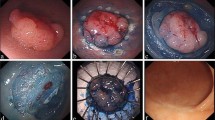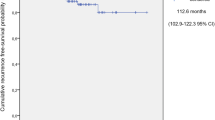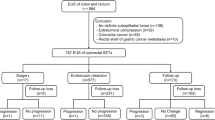Abstract
Background
Colorectal high-grade intraepithelial neoplasia is defined as a high-grade neoplastic lesion with no invasion of submucosa. Because pathological evaluation has inevitable sampling errors, invasive cancer may be underdiagnosed as high-grade intraepithelial neoplasia by regarding submucosa invasion as an indispensable criterion for malignancy. This study was to evaluate the reliability of colorectal “high-grade intraepithelial neoplasia” diagnosis and identify predictive factors of underdiagnosis.
Methods
Colorectal high-grade intraepithelial neoplasia patients treated with complete local excision were followed up. Clinicopathologic features were compared between cases with malignant recurrence or distal metastasis and those without.
Results
Of 491 lesions reviewed, 13 (2.6 %) developed local malignant recurrence or distal metastasis, which were statistically significantly associated with rectal location (p = 0.047), sessile growth (p = 0.002), large diameter (p = 0.005), villous adenoma (p = 0.00), transanal local resection (p = 0.001), and piecemeal specimens (p = 0.009). Of the 13 cases, 11 were located in the rectum, including 10 in the low position (<=6 cm from the anal verge, mean 3.6 cm). Deeper pathological examination was performed on the paraffin-embedded tissue blocks of the 13 primary tumors and revealed no evidence of submucosa invasion.
Conclusion
The diagnosis of colorectal high-grade intraepithelial neoplasia based on local resection is relatively reliable. However, regarding invasion of submucosa as an indispensable criterion for malignancy may contribute to the choice of overly conservative treatment, especially in the situation that the radical resection requires removing the anus.



Similar content being viewed by others
References
Dixon MF (2002) Gastrointestinal epithelial neoplasia: Vienna revisited. Gut 51:130–131
Hamilton SR, Aaltonen LA (2000) Pathology and genetics of tumours of the digestive system. World Health Organization classification of tumors. IARC Press, Lyon
Gschwantler M, Kriwanek S, Langner E et al (2002) High-grade dysplasia and invasive carcinoma in colorectal adenomas: a multivariate analysis of the impact of adenoma and patient characteristics. Eur J Gastroenterol Hepatol 14:183–188
Schlemper RJ, Kato Y, Stolte M (2001) Review of histological classifications of gastrointestinal epithelial neoplasia: differences in diagnosis of early carcinomas between Japanese and Western pathologists. J Gastroenterol 36:445–456
Schlemper RJ, Riddell RH, Kato Y et al (2000) The Vienna classification of gastrointestinal epithelial neoplasia. Gut 47:251–255
Wei XB, Gao XH, Wang H et al (2012) More advanced or aggressive colorectal cancer is associated with a higher incidence of “high-grade intraepithelial neoplasia” on biopsy-based pathological examination. Tech Coloproctol 16:277–283
MacDonald AW, Tayyab M, Arsalani-Zadeh R et al (2010) Intramucosal carcinoma on biopsy reliably predicts invasive colorectal cancer. Dis Colon Rectum 53:1099–1100
Westra WH, Hruban RH, Phelps TH et al (2003) Surgical pathology dissection: an illustrated guide. Springer, New York
Shia J, Klimstra DS (2008) Intramucosal poorly differentiated colorectal carcinoma: can it be managed conservatively? Am J Surg Pathol 32:1586–1588, author reply 1588–1589
Lewin MR, Fenton H, Burkart AL et al (2007) Poorly differentiated colorectal carcinoma with invasion restricted to lamina propria (intramucosal carcinoma): a follow-up study of 15 cases. Am J Surg Pathol 31:1882–1886
Hassan C, Zullo A, Winn S et al (2007) The colorectal malignant polyp: scoping a dilemma. Dig Liver Dis 39:92–100
Seo GJ, Sohn DK, Han KS et al (2010) Recurrence after endoscopic piecemeal mucosal resection for large sessile colorectal polyps. World J Gastroenterol 16:2806–2811
Platell C (2010) Malignant recurrence following TEM excision of a large rectal adenoma. ANZ J Surg 80:468–469
Kishino T, Matsuda T, Sakamoto T et al (2010) Recurrent advanced colonic cancer occurring 11 years after initial endoscopic piecemeal resection: a case report. BMC Gastroenterol 10:87
Gao Y, Zhong WX, Mu DB et al (2008) Distributions of angiogenesis and lymphangiogenesis in gastrointestinal intramucosal tumors. Ann Surg Oncol 15:1117–1123
Schlemper RJ, Kato Y, Stolte M (2000) Diagnostic criteria for gastrointestinal carcinomas in Japan and Western countries: proposal for a new classification system of gastrointestinal epithelial neoplasia. J Gastroenterol Hepatol 15(Suppl):G49–G57
Hochdorffer R, Eickhoff A, Apel D et al (2010) Endoscopic resection of giant colorectal lesions: long-term outcome and safety. Z Gastroenterol 48:741–747
Bujanda L, Cosme A, Gil I et al (2010) Malignant colorectal polyps. World J Gastroenterol 16:3103–3111
Nagorni A, Bjelakovic G (2011) Endoscopic mucosal resection of colorectal tumors—our first experience. Vojnosanit Pregl 68:744–748
Appelman HD (2008) CON: high-grade dysplasia and villous features should not be part of the routine diagnosis of colorectal adenomas. Am J Gastroenterol 103:1329–1331
Authors’ contribution
Xu Biao Wei designed the study, analyzed of data, and drafted the article.
Lei Xin acquired the clinical data and literature, analyzed of data, and drafted the article.
Jun Hao acquired the clinical data and literature and revised the paper.
Author information
Authors and Affiliations
Corresponding author
Additional information
All of the authors acknowledged this title.
Rights and permissions
About this article
Cite this article
Wei, X.B., Xin, L. & Hao, J. Malignant recurrence and distal metastasis after complete local resection of colorectal “high-grade intraepithelial neoplasia”: incidence and risk factors. Int J Colorectal Dis 29, 1467–1475 (2014). https://doi.org/10.1007/s00384-014-2001-0
Accepted:
Published:
Issue Date:
DOI: https://doi.org/10.1007/s00384-014-2001-0




